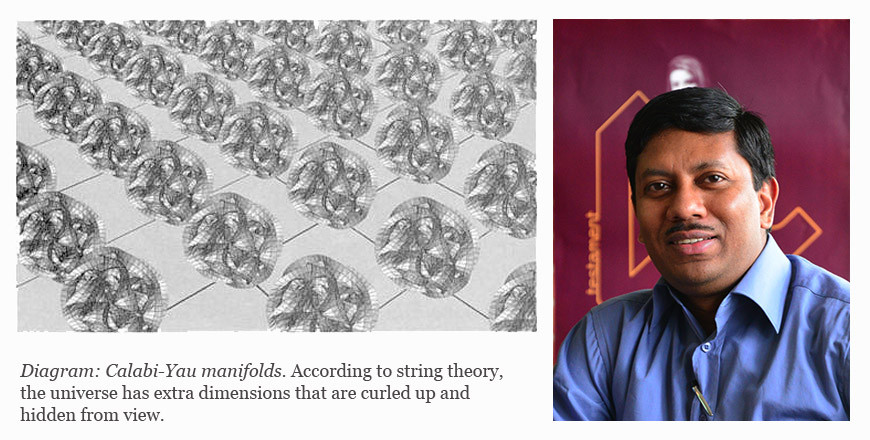
In this talk Professor Keshav Dasgupta from the McGill Physics Department traces the important ideas in the history of modern physics that have given rise to String theory. String theory, a broad and rich field of theoretical physics, was developed to address a number of deep questions in fundamental physics and is most famously known as an attempt to formulate a "Theory of Everything".
Dr. Keshav Dasgupta obtained his PhD at the Tata Instutude of Fundamental Research in Mumbai, India. He then worked as a Postdoc in prestigious universities such as Princeton and Stanford. He subsequently visited University of Illinois as an assistant professor before coming to McGill University in Montreal where he has been an Associate Professor since 2010.
The First Choice Science seminar series: S.P.A.C.E. is partnering with First Choice Science to encourage students in the profile to engage with the expert speakers and ideas presented in the weekly seminars.
Comments
First Choice Science Coordinator
October 9, 2015Excellent talk, enlightening.
Thank you Prof. Dasgupta and all FCS for your input. Keep the discussion rolling!
Chaitanya Varier
October 10, 2015Hi Dr. Dasgupta, really enjoyed this talk. I am curious in understanding exactly how renormalization would make sense physically, and what mathematical problems arose that required it. Also I was wondering how exactly the D-brane model retains the mathematical validity of the Calabi-Yau manifold model?
alexanderhassler
October 10, 2015Many thanks for taking the time to talk to us about such an interesting topic! I was wondering about supersymmetry, and even if we have a limited knowledge about this aspect due to it being a rather recent one, do we know how the charge, mass and attraction of these superparticles compare to the normal particles? For example, if we compared an electron to a superelectron, what would be the forces of attraction between these two and how would the mass and charge compare? Thanks again!
Joshua Mogil
October 13, 2015Thank you for presenting string theory in a way that I was able to understand. It was very interesting to know how all the various theories were formed and eventually led to Superstring theory. I have a question regarding the infinite possible paths a particle can take to reach a destination. I understand that all paths requiring faster than light travel cancel out with each other, but I don’t understand the process.
Keshav
November 4, 2015Hi Joshua:
Thanks for your comments.
The process is a little subtle and is explained in the first few pages in the second chapter of Peskin and Schroeder’s book on quantum field theory. The idea is that outside a light cone the probability of finding the particle can be made zero by doing some transformation on the space-time indices! Inside the light cone this transformation is not possible, so particles can be found.
Hope that helps.
Best,
Keshav
Keshav
November 4, 2015Hi Alexander:
Thats a good question. It turns out, in some cases the total force cancel between particles so that the system gets stabilized. Once we break supersymmetry, we get forces. This process is however not generic, so forces between electrons can be repulsive whereas the forces between selectrons can also be repulsive. The masses and charges are identical, and susy is broken when the masses and charges differ. The proportionality between mass and charge is called the BPS condition (Bogomolnyi-Prasad-Sommerfeld condition).
Hope that helps.
Best,
Keshav
Keshav
November 4, 2015Hi Chaitanya:
Thats a non-trivial question! To understand renormalization, consider an electron. If you go closer to it, you’ll find the force on a test charge particle increasing. However QFT tells us that the space surrounding the electron is dynamical i.e its not empty, and so numerous + and - charges get created! Thus the electron is kind of “shielded” by these charges, and so when you go closer to it, the force on the test charge particle does not change in the way you calculate using classical mechanics. This “slowing” is the renormalization and therefore helps in cancelling the annoying infinities!
The D-brane retains the mathematical consistency of Calabi-Yau manifolds by creating appropriate gravitational back-reaction. This has been worked out in details.
Hope this explains.
Best,
Keshav
Chaitanya Varier
November 21, 2015Hi Dr. Dasgupta, thank you for your answer. Does this specifically mean taking the example of the force exerted on a test particle by an electron, that the force versus distance separation curve would no longer be a perfect rational function (using Coulomb’s law), but rather exhibit some change in concavity at a certain value of r? Also, does QFT explain how these + and - charges are distributed exactly? Or is this entirely probabilistic?
Fatemen
February 5, 2016Keshav, are you saying that electrons themselves, along with quarks, are them theirselves composed of many floating “plum-pudding” charges. Is this why when an electron interacts with a proton (in the electron capture reaction), it transforms one of its up quarks into a down quark, while giving the baryon mass? Do some “entities” within the electron bond with “entities” within an up quark, and certain “entitie(s)” are released from either fermions become a photon? Just as hydrogen and chlorine react to form two hydrogen chloride molecules. How long do you think we can go about entities being made out of entities (molecules made out of atoms made out of baryons made out of quarks made out of ...). Is it possible that this chain is infinite?
You have to be registered and logged in in order to post comments!